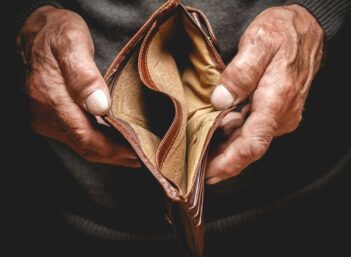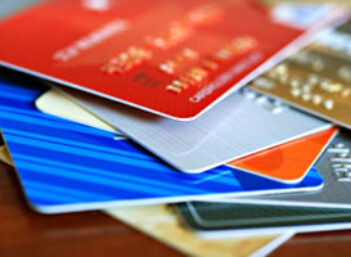Depositing your money into a bank account may feel like the safest place to stash your cash, but are all banks safe? How do you know that your money is protected?
While there are trillions of dollars deposited into US banks, many take it for granted that it will always be there. Unfortunately, banks have been known to fail, especially during financial crises such as the Great Depression and the 2008 Great Recession.
In fact, 489 banks were closed down by the FDIC between 2008 - 2013, which is a staggering number.
Now, putting money in a bank shouldn’t be scary, so we'll cover what makes banks safe, what features to look for in a bank, and give you a list of some of the safest banks in America.
What Makes a Bank Safe?
Banks are where most Americans keep their money, depositing into checking and savings accounts to handle most of their daily financial transactions. While most banks offer protection to depositors, it’s important to know what that protection is, how much of your funds are protected, and what standards most banks are held to.
FDIC Insurance
Before you deposit a dollar into any bank, you want to ensure that the money you put in is protected by the Federal Deposit Insurance Corporation (FDIC). The FDIC is an independent agency created by Congress after the Great Depression to maintain stability and public confidence in the nation's financial system.
Here’s a quick rundown of what you need to know about FDIC insurance;
FDIC insurance covers bank deposits up to $250,000 per individual, per bank, for each ownership category.
If the bank fails, the FDIC will reimburse each deposit up to the insured amount for each account
The FDIC is federally-backed, and member banks pay premiums to insure deposits
What's an ownership category? Ownership categories are the different types of entities that can own bank accounts. For example, you can have a savings account in your name, and then also have a business account in your company's name. Then you may also have a third account in the name of your family trust.
Each of those accounts would be insured separately since they are in different ownership categories. In this case, you could have up to $250,000 insured in each account since they are considered different owners, even though they are all yours.
Joint accounts are per depositor, so an account with two owners would be insured up to $500,000.
What Makes Credit Unions Safe?
Credit unions are member-owned financial institutions that function similar to a traditional bank. Members can deposit funds into checking and savings accounts, get loans for things like cars and homes, and even open a retirement account. Credit Unions are not-for-profit institutions, which means they act in the interest of the owners, which are the members.
While the institutions operate differently than a bank, they do offer similar protections.
NCUA Insurance
The National Credit Union Administration (NCUA) acts in a similar manner as the FDIC, insuring depositor funds at credit unions. These deposits are also insured for up to $250,000 per individual, per credit union, per account type. In the event a credit union fails, the NCUA will reimburse depositors up to the insured amount.
And just like FDIC insurance, joint accounts are insured per depositor. So an account with two owners would be insured up to $500,000.
How to Know if a Bank is Safe
While having a federally-backed agency insure a portion of your deposits is nice, it doesn’t mean the bank is safe. To evaluate the safety of a bank, FDIC or NCUA insurance is a requirement, but you can also research to see which banks are on troubled financial footing.
Probably the most accurate way to do this is using the Texas Ratio. The Texas Ratio was developed by RBC Capital Markets' banking analyst Gerard Cassidy as a way to predict bank failures during the state's 1980s recession.
The Texas Ratio is calculated by dividing the bank's non-performing assets (non-performing loans and the real estate now owned by the bank because it foreclosed on the property) by its tangible common equity and loan loss reserves. While that may seem complicated, the premise is that a bank with more non-performing assets than equity and reserves may be in trouble. So if the Texas Ratio is 1.0 (100%) or higher, the bank is in trouble.
According to S & P Global, only four banks in the US have a Texas Ratio above 100% in Q4 of 2020.
Civic Bank of Rogersville, TN
Grand Rivers Community Bank of Grand Chain, IL
Cecil Bank of Elkton, MD
Towanda State Bank of Towanda, KS
There are a few other banks approaching a 100% Texas ratio on S & P Global’s list, but overall, less than a dozen banks in the US are currently approaching troubled status.
Overall, almost all FDIC insured banks are a safe bet to deposit your funds.
Safety Measures Banks Use
In addition to insuring your deposits, banks offer many safety features to keep your money protected. Here are just a few ways banks help protect consumers from fraud and other financial safety concerns:
$0 (or $50) Fraud Liability
When using a credit card for purchases, most banks offer $0 fraud liability protection against fraudulent purchases on your account. When you report fraudulent activity on your account, the card issuer will freeze the account, open an investigation, and reimburse the charges.
If the card issuer doesn’t offer $0 liability protection, cardholders may need to cover up to $50 of the fraudulent charge costs.
Chips
For debit and credit cardholders, banks are now offering cards with chip-and-pin technology to further protect your card from would-be thieves. The chips that are now prevalent in newer credit and debit cards encrypt your credit card information when they are used, preventing identity thieves from stealing your information from a credit card reader.
CVV Codes
When making purchases online, you may have been promoted to enter a CVV code, also known as the 3- or 4-digit number on the bank of your debit or credit card.
This number is unique to the physical card you own, and it is not stored digitally. This means that even if an identity thief stole your credit card information online, they cannot purchase at a retailer that requires the CVV number, because it is only available on the physical card itself.
Requiring Zip Code at High-Risk Retailers
Occasionally when making a purchase with a credit or debit card, you will be required to enter your billing zip code. This is an extra security step to prevent thieves who have stolen your credit card from making purchases if they do not have your address information.
This is most commonly seen as gas stations, where thieves could purchase gas without ever entering the gas station. It's a quick and quiet way of testing if the card is valid.
If the zip code is not provided, the card transaction will be declined.
Single-Use Card Numbers
Some banks are now providing an extra layer of protection for purchases with single use credit card (or “virtual credit card) numbers. This allows you to assign multiple “virtual” card numbers for a single account, using a separate one for each online retailer you use, with a specific amount allocated to each number.
This protects consumers in two ways:
Your real card number is never used online and,
The amount of funds allocated for each number is limited (by you)
Single-use card numbers are gaining popularity with the rise in identity theft occurring online, helping further protect your funds.
Are Online Banks Safe?
More and more banking is happening online, and many people are opening new bank accounts without ever stepping foot in a brick-and-mortar bank. While online banks may seem more impersonal, it does not mean they are any less safe.
Just like traditional banks, most online banks are FDIC insured, protecting user funds. Online banks also use the latest technology, such as chip cards, and virtual cards, two factor authentication, and have similar liability protection on credit and debit cards.
Before signing up for any online bank, just ensure the accounts are insured before depositing any money.
Safest Banks in America
While most FDIC-insured banks can be considered safe, having a low Texas Ratio means the bank manages its debt well. According to BankRegData.com, out of the top 100 banks (by assets), there are only a few with a Texas ratios below 5.0%.
We can consider these some of the safest banks in America.
| Bank name | Total Assets | Texas Ratio (%) |
| State Street Bank and Trust Company | 313,281,000,000 | 0.00 |
| Charles Schwab Corporation | 396,473,000,000 | 0.28 |
| Bank of New York Mellon Corporation | 417,169,890,000 | 0.58 |
| UBS Bank USA | 91,110,922,000 | 0.86 |
| Stifel Financial Corp. | 20,538,616,000 | 0.89 |
| New York Community Bank | 57,633,106,000 | 1.01 |
| Deutsche Bank Aktiengesellschaft | 37,866,430,000 | 1.04 |
| Silicon Valley Bank | 140,260,913,000 | 1.07 |
| Umpqua Bank | 30,039,015,000 | 1.13 |
| Prosperity Bank | 35,563,929,000 | 1.37 |
| First Republic Bank | 155,797,960,000 | 1.40 |
| Raymond James Bank | 33,220,680,000 | 1.41 |
| FirstBank | 25,882,061,000 | 1.51 |
| Pacific Premier Bank | 20,172,309,000 | 1.69 |
| The Northern Trust Company | 163,541,275,000 | 1.72 |
| Frost Bank | 44,092,014,000 | 1.78 |
| Bank OZK | 27,276,892,000 | 1.85 |
| First Hawaiian Bank | 23,496,497,000 | 2.39 |
| Pinnacle Bank | 35,145,561,000 | 2.44 |
| Royal Bank of Canada | 86,736,280,000 | 2.58 |
| Morgan Stanley | 396,432,452,000 | 2.75 |
| Central Bancompany | 18,962,426,000 | 2.76 |
| South State Bank | 39,608,763,000 | 2.79 |
| UMB Bank | 34,409,284,000 | 2.90 |
| Glacier Bank | 19,759,090,000 | 2.92 |
| Mechanics Bank | 18,944,668,000 | 3.27 |
| Texas Capital Bank | 40,035,375,000 | 3.31 |
| Washington Federal | 19,535,454,000 | 3.50 |
| Investors Bank | 25,770,333,000 | 3.51 |
| Atlantic Union Bank | 19,800,793,000 | 3.52 |
| Wintrust Financial Corporation | 45,667,569,000 | 3.54 |
| Toronto-Dominion Bank | 441,475,159,000 | 4.07 |
| Customers Bank | 18,807,064,000 | 4.15 |
| Hancock Whitney Bank | 35,049,974,000 | 4.29 |
| BancorpSouth Bank | 25,802,759,000 | 4.37 |
| Western Alliance Bank | 43,451,450,000 | 4.60 |
| City National Bank of Florida | 19,742,021,000 | 4.62 |
| United Bank | 26,992,697,000 | 4.72 |
| Canadian Imperial Bank Of Commerce | 44,208,963,000 | 4.76 |
| Comerica Incorporated | 86,333,051,000 | 4.84 |
What Happens if a Bank Fails?
When a bank fails, it means it can no longer meet its debt and depositor obligations. At this point, the FDIC steps in and either sells the bank to another bank, or takes over operations for the bank.
Since the FDIC also insures deposits, if the bank is FDIC insured, depositors will be able to access their insured funds from the FDIC.
When the bank is sold to another bank, account holders will automatically become customers of the purchasing bank. This may mean new account numbers, apps to download, and banking locations will be available.
History of Bank Failures
While banks can fail from time to time, there are a few events in American history that caused a wave of bank failures, losing many Americans their life savings. Here are a few notable ones that helped form the basis of the protections we have today (such as the FDIC):
The Panic of 1819
In 1819, many state-chartered banks failed after demand for US agriculture dried up. Since the FDIC was not appointed yet, many depositors lost their funds.
The Panic of 1837
Many factors contributed (including Andrew Jackson's fiscal policies), but in 1837, 343 out of 850 U.S. banks closed entirely. Many depositors lost their life savings.
The Panic of 1873
In 1873, after much speculation and overbuilding of railroads, many railroad companies declared bankruptcy. Known as the “Long Depression”, this event even caused the New York Stock Exchange to suspend trading for the first time in history. Many banks failed, and no deposits were insured, causing many Americans to lose everything.
The Great Depression (1929 Stock market Crash)
During the Great Depression, over 9,000 banks failed throughout the 1930's due to the stock market crash of 1929. The FDIC was created in response to the financial devastation of the Great Depression to help restore faith in US banks.
Savings and Loan Crisis
Due to high inflation and regulatory factors, over 1,000 Savings and Loan institutions failed by 1989, but the FDIC was able to reimburse all deposits at FDIC-insured banks.
The Great Recession (2008 Financial Crisis)
As mentioned earlier, over 400 banks failed during the 2008 financial crisis. The FDIC was once again able to reimburse depositors and keep insured funds safe.




